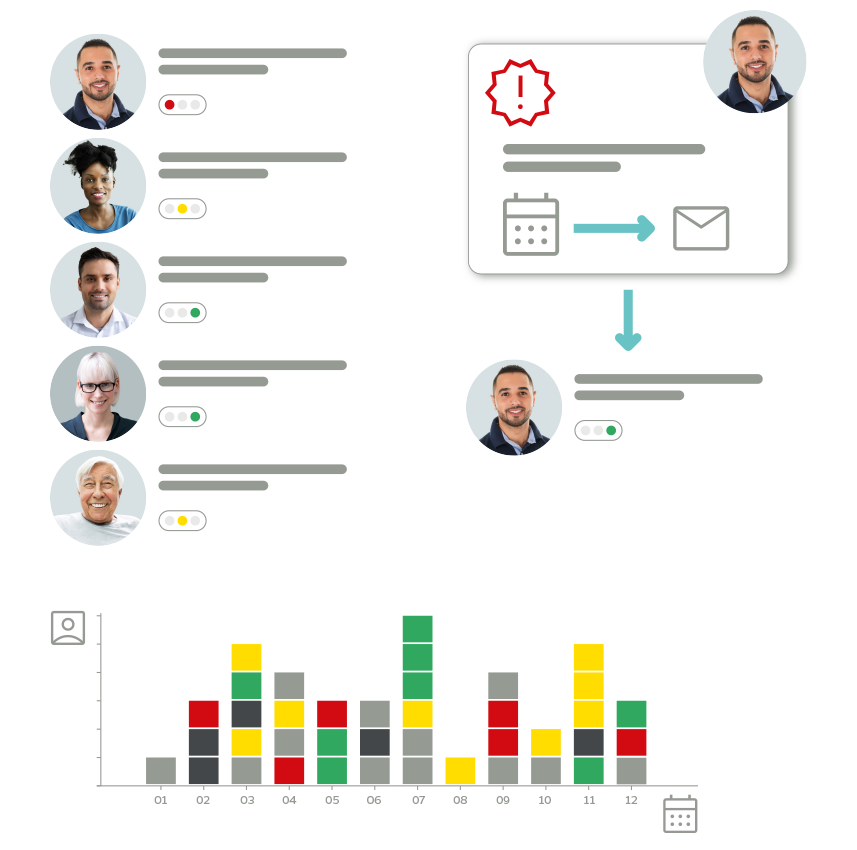The Future of Smart Airport Operations: From Forecasting to Operation Control Supported by Intelligent Software Algorithms

Artificial intelligence (AI) has revolutionized many industries in recent years, and the transportation sector is no exception. AI is capable of supporting a variety of complex tasks in transport management and prediction. A recent study by Gartner highlights the central role that AI, alongside other innovations, will play in the transport sector by 2025. AI offers diverse applications, whether through chatbots in customer service, route optimization, or forecasting for traffic management.
According to Gartner, transportation CIOs are increasingly directing their technology investments toward optimizing business operations and reducing risk. Insights from the 2025 Gartner CIO and Technology Executive Survey reveal that “94% of transportation respondents view improving operating margins as a key benefit of digital technology investments.” Additionally, 90% emphasize the importance of compliance or minimizing risks as a priority.
Gartner highlights that AI offers diverse opportunities that can be distinguished by passenger-focused or operations-focused advancements. While the passenger-focus involves AI to enhance the travel experience itself, the operations-focused advancements aim to enhance the internal processes of transportation providers, concentrating on resource management, performance and cost savings.
Optimizing and increasing efficiency in transport operations begins with the powerful management of resources through highly accurate forecasting. This is where AI-powered technologies, alongside data-insights can make the difference. Especially investments into digital technologies such as workforce management software will have a direct effect on enhancing operating margins and operational excellence.
Workforce management solutions with integrated forecasting tools that are powered by AI-driven algorithms show their full potential, especially in complex environments like airports. Shift scheduling for airport, airline and ground handler operation is a highly complex matter. From several thousand to tens of thousands of employees working 24/7 year-round at large airports, efficient shift planning is essential. From push-back drivers and check-in agents to security staff, numerous employees must be integrated into shift schedules depending on flight schedules and passenger volumes to ensure smooth operations without delays.
How to keep track on this?
Content
↓ How can AI-powered technologies bring operation-focused advancements to airport operations and how can airports benefit?
↓ Why is high accuracy forecasting essential for performance enhancement of airport operations?
↓ What additional functions complement forecasting in workforce management at airports?
How can AI-powered technologies bring operation-focused advancements to airport operations and how can airports benefit?
AI-powered technologies bring significant advantages to airport operations, specifically by optimizing planning processes like the workforce planning and particularly when integrated into modern software systems. One of the core strengths of data-insights generated by AI-algorithms lies in the ability to analyse large volumes of historical and real-time data to forecast staffing needs with high precision. By leveraging intelligent algorithms, a workforce management software can predict demand patterns based on factors such as flight schedules, passenger volumes, weather conditions, and even seasonal fluctuations.
Such data-driven forecasting enables planners to make informed decisions, ensuring the right number of staff are scheduled at the right time and place. In the fast-paced and unpredictable environment of an airport, this level of accuracy is crucial. It not only optimizes planning efforts but also minimizes the risk of over- or understaffing, both of which can lead to operational inefficiencies or increased costs.
Key Benefits include:
Accurate forecasting of staffing needs |
|
– through analysis of historical and real-time data |
Optimized shift planning |
|
– that aligns workforce levels with operational demand |
Real-time adjustment capabilities |
|
– to quickly manage unexpected staff absences |
Reduced planning workload |
|
– by automating complex scheduling processes |
Lower personal costs |
|
– through efficient resource allocation |
Increased operational stability and service quality |
|
– due to consistent staffing |
In daily operations, the use of AI-driven workforce management proves to be a powerful tool for maintaining efficiency, improving flexibility, and ultimately enhancing the performance of airport operations.
Find out more at: Staff Planning for Aviation
Why is high accuracy forecasting essential for performance enhancement of airport operations?
High accuracy forecasting is a key driver of effective workforce planning and overall performance at airports. The combination of historical insights and live operational data empowers airports to make smarter, faster decisions. Staff scheduling becomes proactive rather than reactive—directly enhancing the reliability and performance of airport operations, ensuring seamless processes, and achieving measurable cost efficiencies.
3 Examples for measuring efficiencies related to workforce planning:
- Forecast Accuracy
to assess the quality of data inputs and forecasting algorithms
KPI example: Forecast deviation rate (%) - Staff Utilization Rate
indicates how efficiently staff is planned across shifts
KPI example: (Productive hours / Total scheduled hours) × 100 - Schedule Robustness
evaluates how closely actual staff deployment follows the original plan
KPI example: % of staff adhering to planned schedule
An AI-powered Workforce Management software enables seamless management of dynamic and complex processes in the transportation sector by utilizing real-time data and particularly enabling real-time adaptions with direct influence on efficiency and cost performance.
Find out more at: Staffing Level Analysis

What additional functions complement forecasting in workforce management at airports?
Staff qualifications
Airports have numerous areas where specific qualifications are required. Whether it’s ramp or security personnel, certifications and qualifications must be regularly acquired and demonstrated to be allowed to work in security-critical zones. In other departments, such as check-in, certain skills are also needed, including proficiency in boarding systems and specific language skills. Additionally, ensuring the presence of first responders during all working hours is essential.
A WFM software provides a comprehensive overview of staff and their individual qualifications, ensuring that the right personnel with the necessary skills are always on site. Legal obligations, such as rest periods or shift lengths, are automatically considered in the scheduling process, as are existing company agreements and contractual regulations.
If certifications are about to expire, the software notifies HR personnel in advance so that necessary training can be scheduled well ahead. This ensures that the right staff with the appropriate qualifications are deployed for all tasks—at all times.
Find out more at: Skill Management Software

Staff requests
A good work-life balance is important for airport staff as well. They have their own appointments, working time preferences, and vacation entitlements that should be considered. Modern WFM software allows staff to directly submit vacation requests and shift preferences in advance. These requests and preferences are automatically integrated into the shift planning process. Based on this input, the software generates schedules that, using various optimization algorithms, best accommodate these preferences while ensuring a fair distribution of vacation days, workdays, and less popular shifts—especially during holidays and other peak times. Additionally, employees can flexibly swap shifts among themselves if unexpected personal obligations arise. This not only increases employee satisfaction but also reduces absenteeism and conflicts.
Conclusion
AI-powered technologies are taking over the workplace, including airports. In workforce planning, intelligent algorithms assist with the most complex scheduling processes. Particularly accurate forecasting improves efficiency while enhancing the satisfaction of both customers and employees. In modern air transport organisations precise forecasting and planning should ideally be complemented by additional workforce management features such as skill management and mobile self-service options for employees.
Would you like to find out more?
Further information about our workforce management software and the areas of application can be found here:
→ Workforce Management from plano
Archive
Employee Retention in Retail
We’re Here for You
